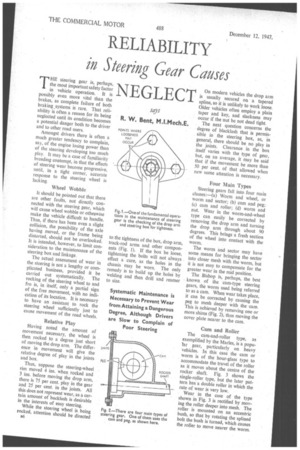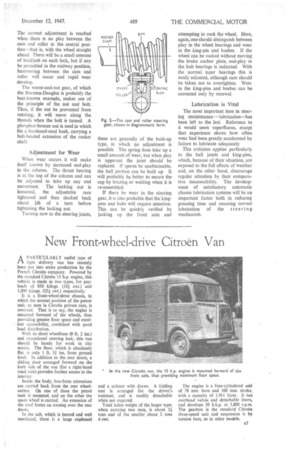RELIABILITY in Steering Gear Causes NEGLECT
Page 40

Page 41

If you've noticed an error in this article please click here to report it so we can fix it.
sqys R. W. Bent, M.I.Mech.E.
THE steering gear is, perhaps, the most important safety factor in vehicle operation. It is possibly even more vital than the brakes, as complete failure of both braking ,systems is rare. That reliability is often a reason for its being neglected until its condition becomes a potential danger both to the driver and to other road users.
Amongst drivers there is often a much greater tendency to complain, say, of the engine losing power than of the steering developing too much play. It may be a case of familiarity breeding contempt, in that the effects of steering wear become progressive, until, in a tight corner, accurate response to the steering wheel is lacking.
Wheel Wobble It should be pointed out that there are other faults, not directly connected with the steering gear, which will cause wheel wobble or otherwise make the vehicle difficult to handle. Thus, if there has been even a slight collision, the possibility of the axle having moved, or the frame being distorted, should not be overlooked. It is intended, however, to limit consideration to the maintenance of the steering box and linkage.
The actual assessment of wear in the steering is not a lengthy or complicated business, provided it be carried out systematically. The rocking of the steering wheel to and fro is, in itself, only a partial sign of the free movement, with no indication of its location. It is necessary to have an assistant to rock the steering wheel sufficiently just ' to cause movement of the road wheels.
Relative Play Having noted the amount of movement necessary, the wheel is then rocked to a degree just short of moving the drop arm. The difference in movement will give the relative degree of play in the joints and box.
Thus, suppose the steering-wheel rim moved 4 ins, when rocked and 3 ins, before moving the drop arm, there is 75 per cent. play in the gear and 25 per cent. in the joints. All this does not represent wear, as a certain amount of backlash is desirable in the interests of easy steering.
While the steering wheel is being rocked, attention should be directed B6 On modern vehicles the drop arm is usually secured on a tapered spline, so it is unlikely to work loose. Older vehicles often employ a plain taper and key, and slackness may occur if the nut be not dead tight.
The next question concerns the degree of blacklash that is permissible in the steering box, as, in general, there should be no play in the joints. Clearance in the box itself varies with the type of gear, but, on an average, it may be said that if the movement be more than 50 per cent, of that allowed when new some attention is necessary.
Four Main Types Steering gears fall into four main classes:—(a) Worm and wheel, or worm and sector; (b) cam and peg; (c) cam and roller; (d) worm and nut. Wear in the worm-and-wheel type can easily be corrected by removing the drop arm and turning the drop arm through about 90 degrees. This brings a fresh section of the wheel into contact with the worm.
The worm and sector may have some means for bringing the sector into closer mesh with the worm, but it is not easy to compensate for the greater wear in the mid position.
The Bishop is, perhaps, the best known of the cam-type steering gears, the worm used being referred to as a cam. When wear takes place, it can be corrected by causing the peg to mesh deeper with the cam. This is achieved by removing one or more shims (Fig. 2), thus moving the cover plate nearer to the cam.
Cam and Roller The cam-and-roller type, as exemplified by the Marks, is a popular gear, particularly on heavy vehicles. In this case the cam or worm is of the hour-glass type to accommodate the travel of the roller as it moves about the centre of the rocker shaft. Fig. 3 shows the single-roller type, but the later pattern has a double roller in which the rate of wear is very low.
Wear in the case of the type shown in Fig. 3 is rectified by moving the roller deeper into mesh. The roller is mounted on an eccentric bush, so that by rotating the splined bolt the bush is turned, which causes the roller to move nearer the worm. The correct adjustment is reached when there is no play between the cam and roller in the central position—that is, with the wheel straight ahead. There will be a small amount of backlash on each lock, but if any be permitted in the midway position, hammering between the cam and roller will occur and rapid • wear develop.
The worm-and-nut gear, of which the Burman-Douglas is probably the best-known example, makes use of the principle of the nut and bolt. Thus, if the nut be prevented from rotating, it will move along the threads when the bolt is turned. A phosphor-bronze nut is used in which fits a hardened-steel bush, carrying a ball-headed extension of the rocker shaft Adjustment for Wear When wear occurs it will make itself known by increased end-play in the column. The thrust bearing is at the top of the column and can be adjusted to take up any end movement. The locking nut is loosened, the adjustable race tightened and then slacked back about ith of a turn before tightening the locking nut.
Turning now to the steering joints, these are generally of the built-up type, in which no adjustment is possible. The spring does take up a small amount of wear, but when play is apparent the joint should be replaced. If spares be unobtainable, the ball portion can be built up It will probably be better to secure the cap by brazing or welding when it is re-assembled.
If there be wear in the steering gear, it is also probable that the kingpins and hubs will require attention. This can be quickly verified by jacking up the front axle and attempting to rock the wheel. Here, again,one should distinguish between play in the wheel bearings and wear in the king-pin and bushes. If the wheel can be rocked without moving the brake anchor plate, end-play in the hub bearings is indicated. With the normal taper bearings this is easily adjusted, although care should be taken not to overtighten. Wear in the king-pins and bushes can be corrected only by renewal.
Lubrication is Vital The most important item in steering Maintenance — lubrication—has been left to the last. Reference to it would seem superfluous, except that experience shows how often wear had been greatly accelerated by failure to lubricate adequately
This criticism applies particularly to the ball joints and king-pins, which, because of their situation, are exposed to the full effects of weather and, on the other hand, discourage regular attention by their comparative inaccessibility. The development of satisfactory automatic chassis lubrication systems will be an important factor both in reducing greasing time and ensuring correct lubrication of the steering mechanism.




















































































